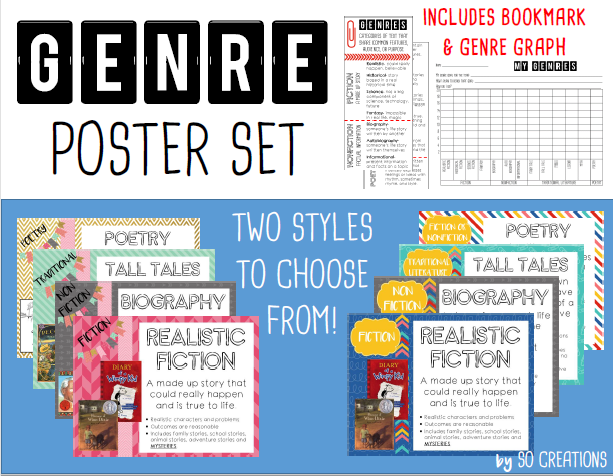
8Uploads
9k+Views
226Downloads
English

Genre Posters, Bookmark, and Graph
With this download you will receive 17 posters in TWO DIFFERENT STYLES!
Each style includes the following posters:
-"Genres" title poster
- Fiction
- Realistic Fiction
- Historical Fiction
- Science Fiction
- Fantasy
- Nonfiction
- Biography
- Autobiography
- Informational Texts
- Traditional Literature
- Fairy Tales
- Tall Tales
- Fables
- Legends
- Myths
- Poetry
You will see that all fiction genres are on the same background color, all nonfiction, etc. This helps students visually categorize genres and subgenres.
Posters include definition and bulleted features of that genre that students can look for in deciding whether a book fits that genre.
Real literature examples are included with every genre!
You can even pull the digital file up on your SMARTBOARD to use as slides for teaching each genre!
Also included is a two-sided bookmarks to print for student use (I suggest cardstock and lamination) and a bar graph for students to track their own genre reading!

Academic Conversation Skills Flipbook for Discussions
Students can use this flipbook as a reference during academic conversation and discussions. These skills should be explicitly taught, and eventually students shouldn't need to reference these speaking stems during conversation. Until they have mastered these speaking skills, this flipbook provides appropriate scaffolding for their conversations. Speaking "stems," "starters," or "frames" have been organized by conversation skill (5 tabs) and even further into ways to prompt the skill through questioning and ways to respond (t-chart on each tab).
The 5 Conversation Skills by which the stems are organized:
1. Elaborate and Clarify Ideas
2. Support Ideas with Examples
3. Build on Ideas or Challenge
4. Paraphrase What's Been Said
5. Synthesize the Conversation

Fiction Conferring Menu - Teaching Points for Reading Conferences
Use this helpful cheat sheet for your conferring with readers at individual or small group reading conferences. This chart lists all the essential fiction reading skills, with conversation starters for the conference, and several strategies to teach for each skill! Don't ever feel stuck in a conference again. With this tool, you will always have a menu of teaching points to choose from!
Skills included:
Choosing a just-right book
Reading unknown words accurately
Reading fluently in phrases
Reading with intonation
Monitoring comprehension
Activating and connecting to background knowledge
Ask questions
Retelling
Summarizing
Predicting
Inferring character traits
Tracking dialogue
Figuring out new vocabulary
Accumulating the story
Determining Importance
Synthesizing

Conferring Notebook for Reading and Writing Workshop
This conferring notebook is everything you need (besides the binder!) to start meeting with students during reading and writing workshops!
Included:
-3 cover pages to choose from
-Conferring Records at a Glance section to track conference frequency with students
-Conferring Calendar section for planning
-Assessment Data section with a Progress Tracker to keep track of reading and writing assessment growth for all students throughout the year
-Strategy Groups sections with a graphic organizer for organizing kids into groups based on need and a notes page for keeping record of all your strategy group meetings
-Individual Conferring section with (1) Student bio page to be printed for each student's section, includes places for their data, their self evaluations, and favorites, (2) PDSA goal setting sheets for students to set and monitor their own goals, and (3) TWO VERSIONS of conferring notes pages to choose from!

Socratic Seminar Scoring Guide/ Rubric (EDITABLE)
"The Socratic seminar is one of the best teaching techniques for engaging students in critical thinking and meaningful discussion of a text. Students are expected to articulate their own thoughts as well as listen and respond to others in the the group. The purpose of the seminar is not to debate or prove a point but to discuss open ended questions and explore many facets of a text." (https://empathyandinquiry.wordpress.com/2016/02/17/in-praise-of-the-socratic-seminar/)
This is a rubric for scoring Socratic Seminar discussions in your classroom. It is a convenient word document, so you can enter your own students names along the top. Simply use checkmarks next to each criteria to assess how students are doing.
Socratic seminars strongly support common core comprehension, speaking, and listening standards.
Distinguish between Below Basic, Basic, Proficient, and Advanced.
Some (but not all) of the criteria included:
-Uses body language and eye contact to indicate active listening for the duration of the seminar
-Both poses and responds to questions
-Builds on the thoughts of others by using appropriate transitions
-Asks clarifying questions
-Quotes the text to support a point
-Uses language of recognition and appreciation to promote collaborative, collegial discussions

6 Hats Critical Thinking Strategy Graphic Organizers
The Six Thinking Hats® is a tool that has been used by people in the business world and the educational community. This methodology of thinking was invented by Dr. Edward De Bono. He is considered an expert in the field of creative thinking and the direct teaching of thinking as a skill. He has written sixty-two books which have been translated into thirty-seven languages. Dr. de Bono has earned, (M.D., Ph.D.), degrees in medicine, psychology, physiology, and philosophy, and Rhodes Scholar. He has held faculty positions at the universities of Oxford, Cambridge, London, and Harvard.
The six hats critical thinking strategy is an excellent tool to be used in any subject area to extend student thinking and understanding. This strategy pushes students to think about the current topic/concept through six different perspectives.
The 6 Hats strategy can be used whole class, in small groups, or individually.
Included in this bundle:
• Table tents for each of the six hats so you can assign each table in your classroom to “put on” one hat and then share out ideas.
• Bookmarks for students to keep in hand during partner work, group work, stations, discussions, etc. I suggest printing these on cardstock and laminating them.
• 5 different graphic organizers that could be used with the 6 Hats strategy
For more information about how to introduce 6 Hats to your class, visit http://sisdtx.sharpschool.com/common/pages/DisplayFile.aspx?itemId=17274974






